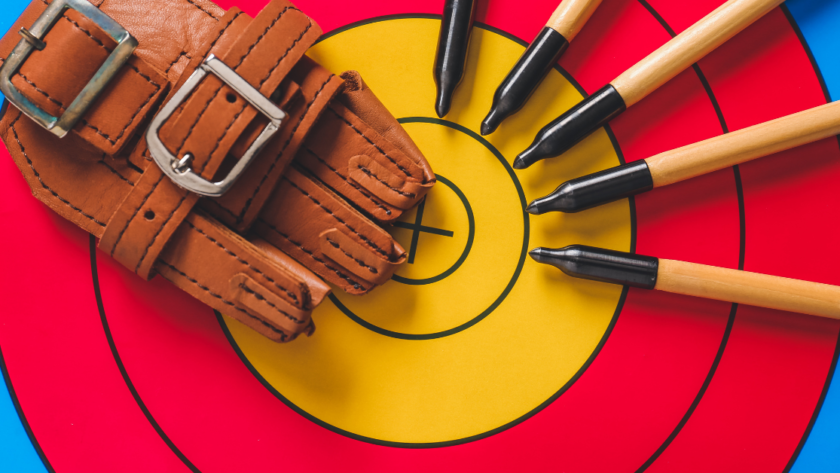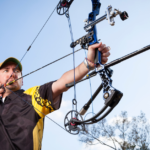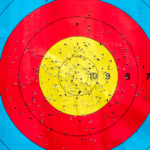As an avid archer with years of experience, I’m excited to share my knowledge about the essential gear every beginner needs to start their archery journey. When I first stepped into an archery shop, I felt overwhelmed by the sheer variety of equipment.
Now, I’m here to simplify that experience for you.
The Bow: Your Primary Tool
The bow is the cornerstone of your archery setup. For beginners, I strongly recommend starting with a recurve bow.
Recurve bows offer simplicity, forgiveness, and affordability compared to compound bows.
They also provide an excellent foundation for developing proper form and technique.
Choosing Your First Recurve Bow
When selecting your first recurve bow, consider these crucial factors:
Draw Weight
Draw weight refers to the force required to pull the bowstring back fully. As a beginner, start with a low draw weight, typically between 20-25 pounds for adults.
This allows you to focus on developing proper form without straining your muscles.
Draw Length
Your draw length should match your arm span. A bow that’s too long or short will feel uncomfortable and negatively impact your accuracy.
Most archery shops can help you measure your draw length accurately.
Riser Material
The riser is the central part of the bow that you hold. While wood offers a traditional look and feel, metal or carbon fiber risers provide more stability for beginners.
These materials are less affected by temperature and humidity changes, ensuring consistent performance.
Takedown vs. One-Piece
Takedown bows allow you to separate the limbs from the riser, making them easier to transport and upgrade. One-piece bows are simpler but offer less flexibility.
For beginners, I recommend a takedown bow for it’s versatility.
Many archery shops offer “try before you buy” programs. Take advantage of these opportunities to find a bow that feels comfortable and natural in your hands.
Arrows: Precision Projectiles
Selecting the right arrows is crucial for both safety and accuracy. Here’s what you need to consider:
Arrow Length
Your arrows should extend about 1-2 inches beyond the front of the bow when drawn. Arrows that are too short can be dangerous, potentially falling off the arrow rest during draw and causing injury.
Conversely, arrows that are too long can negatively affect accuracy and speed.
Arrow Spine
Arrow spine refers to the arrow’s stiffness. It needs to match your bow’s draw weight for optimal flight.
An arrow that’s too stiff or too flexible will fly erratically, reducing accuracy.
Consult with an experienced archer or use an arrow spine chart to find the right match for your setup.
Arrow Material
For beginners, I recommend starting with aluminum arrows. They’re durable, affordable, and forgiving.
As you progress, you might consider carbon fiber arrows, which are lighter and faster but come with a higher price tag.
Fletching
Fletching refers to the “feathers” at the back of the arrow. For beginners, plastic vanes are an excellent choice.
They’re durable, weather-resistant, and suitable for most types of archery.
As you advance, you might explore other options like natural feathers for specific shooting styles.
Arrow Points
For target practice, field points are your go-to choice. They’re inexpensive and easy to remove from targets.
As you progress, you might explore other types of points for different archery disciplines or hunting.
Investing in quality arrows that match your bow and shooting style is crucial. Poorly matched arrows can be frustrating to shoot and potentially dangerous.
Protective Gear: Safety First
While archery is generally a safe sport, proper protective gear is essential to prevent injuries and confirm a comfortable shooting experience.
Arm Guard
An arm guard protects your forearm from the sting of the bowstring upon release. Trust me, you don’t want to experience string slap without one.
Look for an arm guard that covers your forearm from wrist to elbow.
Leather and synthetic materials both work well – choose one that feels comfortable and secure.
Finger Tab or Glove
A finger tab or glove shields your fingers from the friction of the bowstring. This protection is crucial for preventing blisters and allowing for a smooth release.
Finger tabs are typically made of leather and offer excellent protection and feel.
Gloves provide full finger coverage and are popular among traditional archers and hunters.
Chest Guard
While optional, a chest guard is highly recommended, especially for archers with larger chests. It keeps loose clothing out of the way and prevents painful string contact with your chest or shoulder.
Chest guards come in various sizes and styles – choose one that fits comfortably and doesn’t restrict your movement.
The Target: Your Practice Partner
A good target is crucial for practice and enjoyment. Here are some options for beginners:
Foam Targets
Foam targets are durable and easy to remove arrows from. They come in various sizes and shapes, making them versatile for different practice scenarios.
Look for high-density foam targets that can withstand repeated shots without excessive wear.
Bag Targets
Bag targets are excellent for high-volume shooting practice. They’re typically filled with synthetic fibers that stop arrows effectively while allowing for easy removal.
Bag targets are portable and can handle a high number of shots before needing replacement.
3D Targets
Shaped like animals, 3D targets add variety to your practice sessions and are essential if you plan to bow hunt. They help you learn proper shot placement and add an element of realism to your practice.
When starting out, choose a larger target face. As your accuracy improves, you can switch to smaller targets for a greater challenge.
Always confirm your target is placed in front of a suitable backstop to catch any stray arrows.
Essential Accessories
While not strictly necessary to start shooting, these accessories will greatly improve your archery experience:
Quiver
A quiver holds your arrows for easy access during practice. Hip quivers are popular for target archery, while back quivers are often used in traditional archery and hunting.
Choose a quiver that comfortably holds the number of arrows you typically shoot in a session.
Bow Stringer
A bow stringer is a must-have tool for safely stringing and unstringing your recurve bow. It helps prevent limb twist and confirms even tension on both limbs.
Learning to use a bow stringer properly is an essential skill for every recurve archer.
Arrow Rest
An arrow rest helps position the arrow consistently for each shot. For beginners, I recommend a simple stick-on rest or a basic plastic rest.
As you advance, you might explore other options like drop-away rests or whisker biscuits.
Bow Sight
A bow sight aids in aiming, though some archers prefer to shoot “instinctively” without one. For beginners, a simple pin sight can greatly improve accuracy.
As you progress, you might explore multi-pin sights or adjustable competition sights.
Stabilizer
A stabilizer reduces vibration and improves stability, especially helpful for target archery. For beginners, a short stabilizer (around 8-12 inches) can provide noticeable benefits without adding too much weight to your bow.
Maintenance Tools: Keeping Your Gear in Top Shape
Proper maintenance extends the life of your equipment and confirms consistent performance. Here are some essential maintenance tools:
Bow Wax
Regularly waxing your bowstring prevents fraying and extends it’s life. Apply a thin layer of wax every few shooting sessions or whenever the string looks dry.
Avoid over-waxing, as this can attract dirt and debris.
Allen Wrenches
A set of Allen wrenches is necessary for adjusting various bow components, including the sight, stabilizer, and limb bolts on takedown bows. Keep a set in your archery bag for on-the-spot adjustments.
Arrow Puller
An arrow puller helps remove arrows from tough targets without damaging them. It provides a better grip and leverage, reducing the risk of bending or breaking arrows during removal.
Bow Case
A bow case protects your bow during storage and transport. Soft cases are lightweight and affordable, while hard cases offer maximum protection.
Choose a case that fits your bow and accessories comfortably.
String Serving Tool
A string serving tool is used to repair or replace the serving on your bowstring. While not immediately necessary for beginners, learning to maintain your string can save money and extend it’s life.
Putting It All Together: Getting Started
Now that we’ve covered the essential gear, let’s talk about how to put it all together and start shooting.
Setting Up Your Equipment
- Stringing Your Bow: Always use a bow stringer to string your recurve bow.
This confirms even pressure on the limbs and prevents twisting.
- Adjusting Your Draw Weight: If you have a takedown bow, you can adjust the draw weight slightly by tightening or loosening the limb bolts.
Start at the lowest setting and gradually increase as your strength improves.
- Setting Up Your Sight: If using a sight, start with it centered both vertically and horizontally.
You’ll adjust it based on your shooting results.
- Nocking Point: Attach a nocking point to your string.
This confirms consistent arrow placement.
Most beginners start with the nocking point about 1/2 inch above perpendicular to the arrow rest.
Your First Practice Session
- Warm-Up: Start with some light stretching, focusing on your shoulders, arms, and back.
- Stance: Stand perpendicular to the target, feet shoulder-width apart.
- Nocking the Arrow: Place the arrow on the rest and clip it onto the string at the nocking point.
- Drawing the Bow: Use your back muscles to draw the string, bringing your hand to a consistent anchor point on your face.
- Aiming: If using a sight, align the pin with the target.
If shooting instinctively, focus on the target.
- Release: Relax your fingers to release the string smoothly.
- Follow-Through: Maintain your position until the arrow hits the target.
Start by shooting at a large, close target. Focus on developing a consistent anchor point and a smooth release.
Don’t worry about hitting the bullseye at first – consistency is more important than accuracy at this stage.
Common Pitfalls and How to Avoid Them
As you begin your archery journey, be aware of these common beginner mistakes:
Choosing a Bow with Too High Draw Weight
Many beginners are tempted to start with a higher draw weight than they can handle. This leads to poor form and potential injury.
Start low and work your way up as your strength and technique improve.
Neglecting Proper Form
In the excitement of shooting, it’s easy to focus on hitting the target rather than maintaining good form. Remember, consistent form leads to consistent accuracy.
Take the time to develop proper technique from the start.
Inconsistent Anchor Points
Your anchor point is where your drawing hand consistently touches your face at full draw. Varying this point leads to inconsistent shots.
Choose a comfortable anchor point and stick with it.
Failing to Maintain Equipment
Regular maintenance keeps your equipment safe and performing optimally. Inspect your gear before each session, wax your string regularly, and replace worn parts promptly.
Overambitious Practice
While enthusiasm is great, trying to shoot too many arrows too quickly can lead to fatigue and poor form. Quality practice is more important than quantity.
Start with shorter sessions and gradually increase as your stamina improves.
Advancing Your Skills
As you become more comfortable with the basics, consider these ways to advance your skills:
Try Different Archery Disciplines
Explore various archery styles to find what you enjoy most:
- Target Archery: Focuses on hitting precise points at known distances.
- Field Archery: Involves shooting at targets of varying distances, often in outdoor settings.
- 3D Archery: Uses life-sized animal targets and is popular with hunters.
Join an Archery Club
Archery clubs offer access to ranges, equipment, and experienced archers who can provide guidance and tips.
Attend a Workshop or Clinic
Many archery shops and clubs offer workshops for beginners and intermediate archers. These can be excellent opportunities to refine your technique and learn from experts.
Practice Mental Game
Archery is as much a mental sport as it is physical. Practice visualization techniques and learn to manage competition nerves.
Experiment with Equipment
As you progress, you might want to try different types of bows, arrows, or accessories. Always make changes gradually to understand how they affect your shooting.
Reinforcing Your Learning
To solidify your archery skills, try these exercises:
Blank Bale Shooting
Practice your stance and draw without actually releasing an arrow. This “blank bale” technique helps build muscle memory without the distraction of aiming.
Distance Estimation
Set up targets at various distances and practice estimating range. This skill is particularly useful for field archery and hunting.
Blind Shooting
Try shooting with your eyes closed (at a very close target) to focus on the feel of a good release. This helps develop a consistent, smooth release technique.
Form Analysis
Use a mirror or have a friend video your shooting. Analyzing your form can help you identify and fix any inconsistencies.
Key Takeaways
- Start with a recurve bow of suitable draw weight and length
- Invest in properly matched arrows and essential protective gear
- Choose a target that suits your practice needs
- Don’t neglect maintenance tools and accessories
- Focus on developing consistent form before worrying about accuracy
- Be patient and enjoy the learning process
People Also Asked
What is the best beginner bow for archery?
The best beginner bow depends on your goals, but a recurve bow is often recommended for newcomers. It’s simple to use, affordable, and widely used in training and competitions. Brands like Samick Sage or Bear Archery offer reliable options for beginners.
How much does it cost to start archery as a hobby?
Starting archery can cost between $150 to $500, depending on the equipment quality and whether you join a range or club. A basic recurve bow, arrows, a quiver, and protective gear are enough to get you started.
What draw weight should a beginner use?
Beginners should start with a draw weight of 15-25 pounds for adults. For children, a draw weight of 10-15 pounds is suitable. Starting light helps you develop proper form without overstraining.
Is archery an expensive hobby?
Archery can be affordable when starting out, but costs can increase if you upgrade to high-end equipment or compete. Basic gear and range fees are reasonably priced, making it accessible for most budgets.
How often should I practice archery as a beginner?
As a beginner, practicing 2-3 times per week for about an hour each session is ideal. Consistent practice helps you develop muscle memory, improve accuracy, and build confidence.
Can I learn archery on my own?
Yes, you can learn archery on your own with the help of online tutorials, guides, and self-practice. However, working with an experienced instructor early on can significantly improve your technique and safety.
What muscles does archery work out?
Archery primarily works your back, shoulders, chest, and core muscles. The repeated drawing motion engages the latissimus dorsi, deltoids, trapezius, and abdominal muscles, helping build strength and stability.
Is archery good for fat loss?
While archery is not a high-intensity workout, it burns about 140-200 calories per hour and engages multiple muscle groups. Combined with a healthy lifestyle, it can contribute to fat loss and overall fitness.
How dangerous is archery?
Archery is a relatively safe sport when proper safety measures are followed. Using the right equipment, maintaining a safe shooting range, and wearing protective gear help minimize risks.
What age can kids start learning archery?
Children can start learning archery as young as 6-8 years old, depending on their strength, focus, and maturity level. Many programs offer youth-sized bows and structured lessons to ensure safety and fun.



